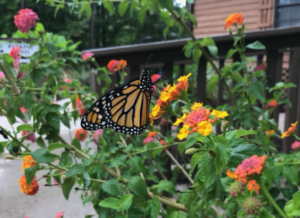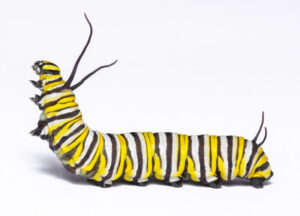Duke Lemur Center Monarch Waystation
The Duke Lemur Center is its own hundred-acre wood, made up of lush green patches of the Duke Forest, where lemurs spend the summer playing and climbing in the trees. But within the peaceful forests of the DLC, lemurs aren’t the only wildlife you’ll find. The expanse of native woodland is home to a number of North Carolina critters like box turtles, black snakes, bull frogs, gray squirrels, bats, and even gray foxes. While helping to protect lemurs in their native Madagascar, the DLC also serves as a valuable habitat for the local fauna, including another highly vulnerable species—the monarch butterfly.

A monarch butterfly rests on a flower outside of the Lemur Landing Visitor Center and Gift Shop.
Every year, monarch butterflies undertake an incredible 3,000 mile journey, making their way from Canada to Mexico to spend the winter. This epic migration takes 3-5 generations of butterflies to complete, and is fueled by the monarch’s choice food source: milkweed. Sometimes called “milkweed butterflies,” monarchs are heavily reliant on the milkweed plant, both for sustenance and as a place to lay their eggs. Adult monarchs require nectar from a variety of flowers in addition to depending on milkweed during their caterpillar phase, and act as pollinators for many wildflower species.
Named after its milky sap, the milkweed plant contains toxins called cardenolides, which cause vomiting and cardiac dysfunction in animals that consume it. Monarch caterpillars have adapted to be able to consume this toxic plant exclusively, which in turn makes them toxic to other animals. In this way, the milkweed protects the monarch for the rest of its life, as predatory animals often avoid eating them.

Unfortunately, milkweed and many other native flowering plants are being eliminated from the monarch’s habitat range in the United States due to the development and use of pesticides and herbicides in croplands and pastures. About 6,000 acres of monarch habitat are lost to development every day, creating fewer and fewer “pit stops” for the insects during their migration. Loss and damage of their wintering sites in Mexico and Southern California are also destructive to monarch populations, and climate change plays a part in disturbing the monarch’s delicate life and migration timing.
Recent population counts of monarchs gathered in their overwintering sites in Mexico have reported an 80% decrease from 1999 to 2016, with other sites reporting even higher losses. These recent, extreme changes to the monarch population have been met with a strong response from scientists and conservationists in North America, to both identify and solve the major problems facing monarch butterflies. One main conservation focus has been restoring natural habitats and purposefully planting milkweed-rich pollinator gardens throughout the monarchs’ migration routes. Additional protection of the monarchs’ overwintering sites in Mexico and California are also in place to protect the butterflies once they reach their destination.

The Duke Lemur Center made the decision to create its own monarch-friendly space in 2017. With help from local horticulturalist Sheri Taylor, the DLC transformed its tour path and grounds into a flourishing garden of native and pollinator-friendly plants, including three varieties of milkweed. Before planting, the safety of milkweed for the lemurs was verified by the vet staff, to ensure that the milkweed could spread and propagate without causing a problem for free-ranging lemurs. With an excellent pollinator habitat in place, the DLC became a certified Monarch Waystation through the organization Monarch Watch. Monarch Watch assists with monarch research and education, providing opportunities for citizen science projects like the creation of monarch waystations, home-raising monarch butterflies, and assisting with migration observations. Since the official certification of the Monarch Waystation at the DLC, monarch caterpillars have been observed chowing down on the milkweed plants, and occasionally hanging out all the way through their metamorphosis!

The monarch waystation on the tour path.
Every time we see a monarch butterfly flitting its way through the lemur enclosures, we are reminded that conservation starts in our own backyard. The DLC-SAVA Conservation Project in Madagascar focuses heavily on community-based conservation efforts to support both the people and lemurs of the SAVA region. While the DLC is dedicated to protecting rare and endangered lemurs across the world, it is also dedicated to protecting biodiversity all over the planet. When guests come to take a tour of the DLC, they walk through our Monarch Waystation on their way to see the lemurs. We hope that our dedication to conserving all of Earth’s species can serve as both inspiration and a call to action.
References
Boyle, John H., Harmony J. Dalgleish, and J. R. Puzey. “Monarch butterfly and milkweed decline substantially predate the use of genetically modified crops.” Proceedings of the National Academy of Sciences 116.8 (2019): 3006-3011.
David N. Zaya, Ian S. Pearse, Greg Spyreas, Long-Term Trends in Midwestern Milkweed Abundances and Their Relevance to Monarch Butterfly Declines, BioScience, Volume 67, Issue 4, April 2017, Pages 343–356.
Pleasants, John M., et al. “Interpreting surveys to estimate the size of the monarch butterfly population: Pitfalls and prospects.” PLoS One 12.7 (2017): e0181245.
Vernimmen, Tim. “How Monarch Butterflies Evolved to Eat a Poisonous Plant – Scientific American.” Scientific American, Scientific American, https://www.scientificamerican.com/article/how-monarch-butterflies-evolved-to-eat-a-poisonous-plant/. Accessed 8 Sept. 2021.

